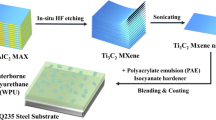Abstract
The erosion pits formed in an ultrasound vibration cavitation were compared to those corrosion pits formed in static water. Concentric iridescent rings around the erosion pit make it different from those corrosion pits. The distinct color and the α-FeOOH structure of the rings indicated that the iridescent rings were oxidization film formed under high temperature generated in the cavitation environment. According to the direct observation on the development of the iridescent rings under microscope, the formation of the iridescent rings was attributed to the repeated interactions between mechanical removal and high temperature oxidization during the cavitation erosion. This work also illustrated the synergistic effect of erosion-enhanced corrosion during the cavitation erosion.





Similar content being viewed by others
References
Shrestha, S., Hodgkies, T., Neville, A.: Erosion–corrosion behavior of high velocity oxy-fuel Ni–Cr–Mo–Si–B coating under high-velocity seawater jet impingement. Wear 259, 208–218 (2005)
Chen, H.S., Li, J., Liu, S.H.: Thermal effect at the incipient stage of cavitation erosion on a stainless steel. J. Fluid Eng. 231, 1–3 (2009)
Chen, H.: Iridescent rings around cavitation erosion pits on surface of mild carbon steel. Wear 269, 602–606 (2010)
Chen, H., Li, J., Chen, D., Wang, J.: Damages on steel surface at the incubation stage of the vibration cavitation erosion in water. Wear 265, 692–698 (2008)
Chen, H., Li, J., Chen, D., Wang, J.: Affected zone generated around the erosion pit on carbon steel surface at the incipient stage of vibration cavitation. Chin. Sci. Bull. 53, 943–947 (2008)
Chen, H., Li, J.: A ring area formed around the erosion pit on 1Cr18Ni9Ti stainless steel surface in incipient cavitation erosion. Wear 266, 884–887 (2009)
Karrab, S.A., Doheim, M.A., Mohamed, S., Ahmed, S.M.: Investigation of the ring area around cavitation erosion pits on the surface of carbon steel. Tribol. Lett. 45, 437–444 (2012)
Wang, W., Zhang, X., Wang, J.: Pits with colored halos formed on 1Cr18Ni9Ti stainless steel surface after ennoblement in seawater. Mater. Sci. Eng., C 29, 851–855 (2009)
Ahmed, S.M., Hokkirigawa, K., Ito, Y., Oba, R., Matsudaira, Y.: Scanning electron microscopy observation on the incubation period of vibration cavitation erosion. Wear 142, 303–314 (1991)
Hodgkiess, T., Neville, A., Shrestha, S.: Electrochemical and mechanical interactions during erosion–corrosion of a high-velocity oxy-fuel coating and a stainless steel. Wear 233–235, 623–634 (1999)
Wood, R.J.K., Wharton, J.A., Speyer, A.J., Tan, K.S.: Investigation of erosion–corrosion processes using electrochemical noise measurement. Tribol. Int. 35, 631–641 (2002)
Jana, B.D., Stack, M.M.: Modeling impact angle effects on erosion–corrosion of pure metals: construction of materials performance maps. Wear 259, 243–255 (2005)
Stack, M.M., Corlett, N., Turgoose, S.: Some recent advances in the development of theoretical approaches for the construction of erosion–corrosion maps in aqueous conditions. Wear 233–235, 535–541 (1999)
Marques, P.V., da Trevisan, R.E.: An SEM-based method for the evolution of the cavitation erosion behavior of materials. Mater. Charact. 41, 193–200 (1998)
Karimi, A., Avellan, F.: Comparison of erosion mechanisms in different types of cavitations. Wear 113, 305–322 (1986)
Franc, J.P.: Incubation time and cavitation erosion rate of work-hardening materials. J. Fluid Eng. 131, 1–14 (2009)
Misawa, T., Hashimoto, K., Shimodaira, S.: The mechanism of formation of iron oxide and oxyhydroxides in aqueous solutions at room temperature. Corros. Sci. 14, 131–149 (1974)
Bourne, N.K., Milne, A.M.: The temperature of a shock-collapsed cavity. Proc. Royal Soc. A Math. Phys. Eng. Sci. 1101, 1851–1860 (2002)
Szeri, A.J., Storey, B.D., Pearson, A., Blake, J.R.: Heat and mass transfer during the violent collapse of nonspherical bubbles. Phys. Fluids 15, 2576–2586 (2003)
Harvey, E.N., McElroy, W.D., Whiteley, A.H.: On cavity formation in water. J. Appl. Phys. 18, 162–172 (1947)
Bai, L., Xu, W.: A high-speed photographic study of ultrasonic cavitation near rigid boundary. J. Hydrodyn. 20, 637–644 (2008)
Acknowledgments
This work is supported by NSFC Project (No. 51275266 and 51275036) and the Fundamental Research Funds for the Central Universities (FRF-TP-09-013A). And the authors would like to thank Liu Caiyun for her previous investigation on this work.
Author information
Authors and Affiliations
Corresponding author
Rights and permissions
About this article
Cite this article
Li, J., Wu, B. & Chen, H. Formation and Development of Iridescent Rings Around Cavitation Erosion Pits. Tribol Lett 52, 495–500 (2013). https://doi.org/10.1007/s11249-013-0234-7
Received:
Accepted:
Published:
Issue Date:
DOI: https://doi.org/10.1007/s11249-013-0234-7




